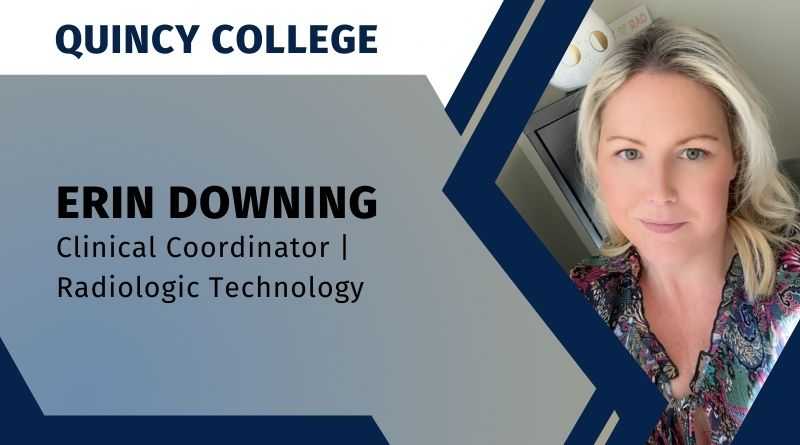Diagnostic Imaging without a lead shield?
By Erin Downing B.S.,R.T.(R)(ARRT), Clinical Coordinator | Radiologic Technology, Quincy College
In January 2021, the National Council on Radiation Protection and Measurements (NCRP) made a surprising announcement: “NCRP has concluded that in most circumstances Gonadal Shielding (GS) use does not contribute significantly to reducing risks from exposure and may have the unintended consequences of increased exposure and loss of valuable diagnostic information, and therefore the use of GS is not justified as a routine part of radiological protection.” (The National Council on Radiation Protection and Measurements, 2021) The movement to stop shielding had started before this official proclamation from the NCRP. Top Physicists and Radiologists across the globe have been calling for change.
Shielding of the reproductive organs has been standard in the United States since it was first recommended in the 1950s. Generations have been raised seeing lead shields used and believing that being shielded is to be “safe.” In reality, there is no “safe” dose of radiation, nor did lead shielding really ever lower the dose of radiation received. Radiation is absorbed into the body at the site of application. (i.e., the chest area for a chest x-ray exam) Once absorbed, the radiation spreads throughout the entire body. Covering any section of the body externally, will not stop the radiation from spreading internally.
Healthcare team to collaborate on this change to make it effective and to make our patients feel assured that they are receiving the best care possible.
Why lead? Lead was chosen as the material used in protective aprons because of its high atomic number. This means it is highly dense and capable of blocking radiation from penetrating through. Another great thing about lead is that it is a relatively cheap material, making it easily available.
Over the past seventy years, technology has advanced, as has our knowledge of radiation and how it affects the human body. Covering reproductive organs during X-rays began after studies in fruit flies prompted a concern that radiation might damage human DNA, causing birth defects. There have never been any studies done or instances seen where X-rays were proven to cause such damage.
Traditional X-ray machines used film to produce images. Even on these older film machines, the X-ray dose was not overly large. Having a chest X-ray was comparable to simply living ten days on Earth. Humans constantly receive minuscule doses of radiation from the sun and atmosphere simply by living here on the blue planet.
The equipment used in most U.S. hospitals and clinics nowadays uses even less radiation. The average patient dose today is 80-95% less than in previous decades. The drop in dose comes from switching over to digital radiography. The X-ray machines now run on a computer. There is a smaller origin dose of radiation sent to the patient, and the computer uses that to create an image. The computer’s capabilities allow even borderline images to be “fixed” or made diagnostic in post-editing. This saves the technologist from having to repeat images, thus saving patients from a double dose. On top of the massive reduction in absorbed dose is the increased resolution and accuracy of the images obtained.
After the NRCP’s announcement, many other professional societies in radiology also came forward to support the measure to stop patient shielding in diagnostic imaging. They include The American College of Radiology (ACR), The American Board of Radiology (ABR) and the American Society of Radiologic Technologists (ASRT).
The group that was slowest to adapt to this new change were the patients themselves, the general public. It is exceedingly difficult to convince people that a widely held belief is incorrect. The word itself, radiation, strikes fear in people. Hiroshima, The Cold War and Chernobyl are all traumatic events connected to radiation that Americans have lived through. How can it be safe to have an X-ray without some sort of protection?
Adding to the confusion of patients is the fact that many radiology centers were slow to adopt the novel changes. If a patient has an x-ray at hospital A and is shielded, then they have an x-ray at hospital B and are not shielded; who do they believe? It is now three years since lead shielding was to be discontinued and we still have patients questioning it. We also still have centers that are continuing to shield. Until the change is adopted universally, we will never be able to instill confidence in the populous as a whole.
At our clinic, I created a small pamphlet explaining the change, what it means and why we implemented it. Whenever a patient asks about shielding and/or feels hesitant about it, we give them the material to take home and read at their leisure. If a patient is especially weary or insistent, we will shield them for their own piece of mind and comfort.
Another obstacle in the fight for consistency is that the dental community has been reluctant to stop shielding for dental X-rays. This further confounds the patient. Why would an x-ray of teeth need shielding, but not any other part of the body? We really need the entire Healthcare team to collaborate on this change to make it effective and to make our patients feel assured that they are receiving the best care possible.

